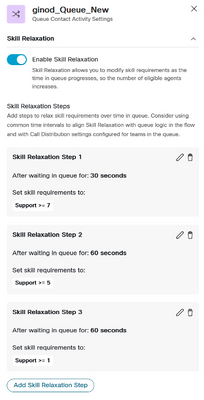Introduction
This document describes the steps to configure Routing with Skill Relaxation in Webex Contact Center.
Prerequisites
Requirements
Cisco recommends that you have knowledge of these topics:
- Webex Contact Center Flow Control Activities and Flow
- Webex Contact Center skill based routing
Components Used
The information in this document is based on these Webex contact center software version:
- Webex Contact Center Flow Control
The information in this document was created from the devices in a specific lab environment. All of the devices used in this document started with a cleared (default) configuration. If your network is live, ensure that you understand the potential impact of any command.
Background Information
Webex Contact Center core principle is to make routing simpler and dynamic for the administrators/supervisors/flow designers so that changes are made on the fly as per the business needs. It is very important for businesses to choose the right routing strategy for their contact center irrespective of the channels consumed by the client. Routing performs a similar function for the contact center as power plant (Engine + Propeller) for an aircraft. It has become the foremost priority for administrators to use the routing strategy efficiently to make sure that any client is not frustrated when it waits in the queue for the right resource. Webex Contact Center offers Skill relaxation option as part of the SBR (Skill-based Routing) setup which helps the administrators/flow developer to prescriptively match an individual with a resource that can quickly resolve their need. Skill relaxation helps to dynamically adjust the assigned skill requirements to a flow in response to client wait times and service level. Administrators/Flow developer can configure multiple number of steps as part of the skill relaxation configuration. The aim of the blog is to provide instructions to configure SBR with Skill relaxation with multiple steps.
Configure

Verify
Configurations

The previous image highlights the SBR with Skill relaxation configuration. The goal of skill relaxation is to provide a mechanism to match the specific attributes of a client with the unique skill set of available agents, within service level. This approach balances the need to support both efficiency and effectiveness in the contact center environment. With Skill relaxation configuration agent pools can be selected from different steps and can form ring-based selection.
In the example above, a contact center maintains a 60 second service level target to manage interactions in the support group. For specific clients, more skilled support technicians are desired to handle more complex, detailed interactions. To support this requirement, skill relaxation can be used to look for highly skilled service representatives first, and match the agent skill proficiency with the complexity level of the interaction. To understand that the service level target is 60 seconds, the routing logic can optimize agent selection when it looks for a resource with the right experience while the contact is safely within service level. If a resource is found, the contact is delivered to the agent that provides the best match. If no resource is immediately found, and the service level targets approach, skill relaxation can widen the agent pool to include resources that are less experienced in the intent of the contact but still able to provide service. The agent pool can be expanded as wide as possible based on the business goals of the contact center.
Related Information



 Feedback
Feedback